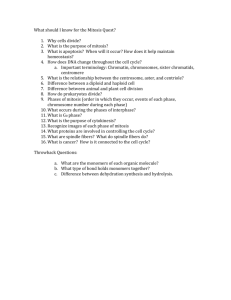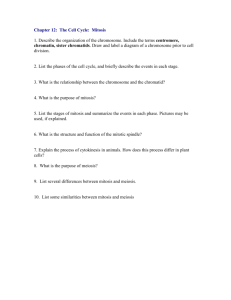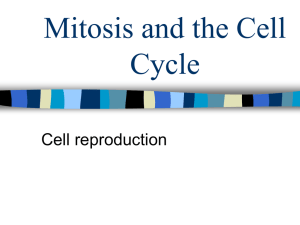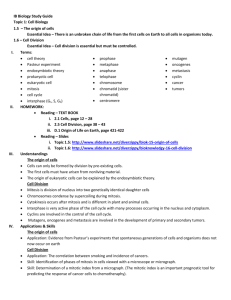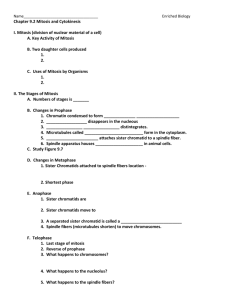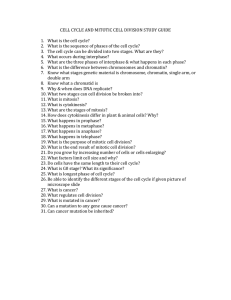Colcemid and the mitotic cycle
advertisement
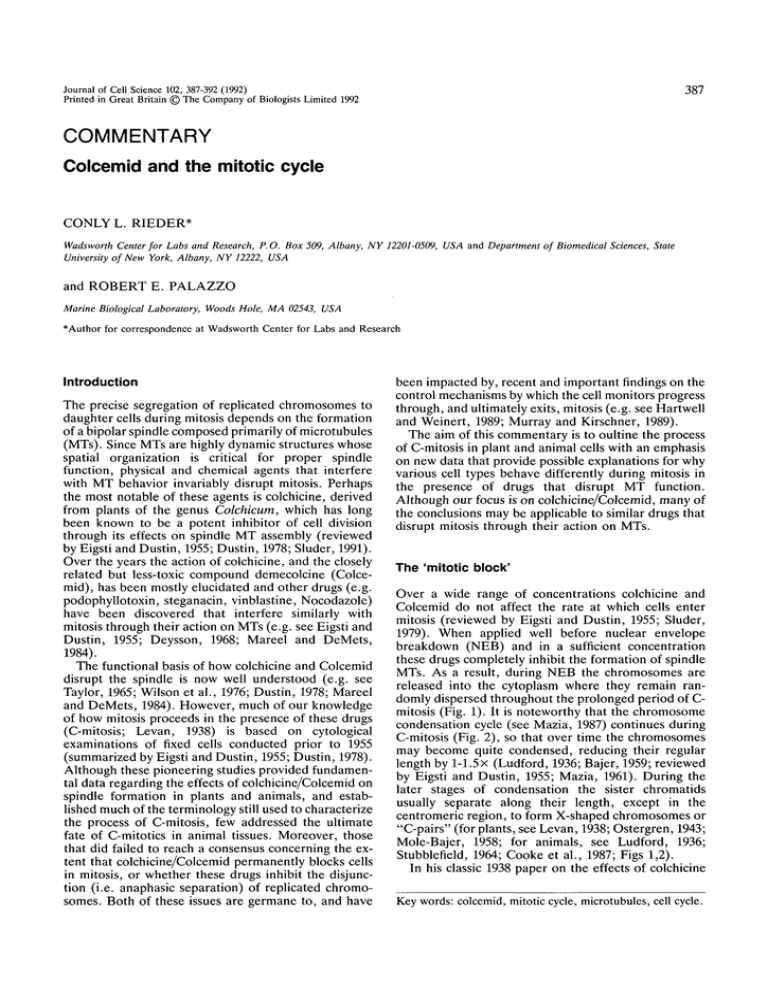
387 Journal of Cell Science 102, 387-392 (1992) Printed in Great Britain © The Company of Biologists Limited 1992 COMMENTARY Colcemid and the mitotic cycle CONLY L. RIEDER* Wadsworth Center for Labs and Research, P.O. Box 509, Albany, NY 12201-0509, USA and Department of Biomedical Sciences, State University of New York, Albany, NY 12222, USA and ROBERT E. PALAZZO Marine Biological Laboratory, Woods Hole, MA 02543, USA *Author for correspondence at Wadsworth Center for Labs and Research Introduction The precise segregation of replicated chromosomes to daughter cells during mitosis depends on the formation of a bipolar spindle composed primarily of microtubules (MTs). Since MTs are highly dynamic structures whose spatial organization is critical for proper spindle function, physical and chemical agents that interfere with MT behavior invariably disrupt mitosis. Perhaps the most notable of these agents is colchicine, derived from plants of the genus Colchicum, which has long been known to be a potent inhibitor of cell division through its effects on spindle MT assembly (reviewed by Eigsti and Dustin, 1955; Dustin, 1978; Sluder, 1991). Over the years the action of colchicine, and the closely related but less-toxic compound demecolcine (Colcemid), has been mostly elucidated and other drugs (e.g. podophyllotoxin, steganacin, vinblastine, Nocodazole) have been discovered that interfere similarly with mitosis through their action on MTs (e.g. see Eigsti and Dustin, 1955; Deysson, 1968; Mareel and DeMets, 1984). The functional basis of how colchicine and Colcemid disrupt the spindle is now well understood (e.g. see Taylor, 1965; Wilson et al., 1976; Dustin, 1978; Mareel and DeMets, 1984). However, much of our knowledge of how mitosis proceeds in the presence of these drugs (C-mitosis; Levan, 1938) is based on cytological examinations of fixed cells conducted prior to 1955 (summarized by Eigsti and Dustin, 1955; Dustin, 1978). Although these pioneering studies provided fundamental data regarding the effects of colchicine/Colcemid on spindle formation in plants and animals, and established much of the terminology still used to characterize the process of C-mitosis, few addressed the ultimate fate of C-mitotics in animal tissues. Moreover, those that did failed to reach a consensus concerning the extent that colchicine/Colcemid permanently blocks cells in mitosis, or whether these drugs inhibit the disjunction (i.e. anaphasic separation) of replicated chromosomes. Both of these issues are germane to, and have been impacted by, recent and important findings on the control mechanisms by which the cell monitors progress through, and ultimately exits, mitosis (e.g. see Hartwell and Weinert, 1989; Murray and Kirschner, 1989). The aim of this commentary is to oultine the process of C-mitosis in plant and animal cells with an emphasis on new data that provide possible explanations for why various cell types behave differently during mitosis in the presence of drugs that disrupt MT function. Although our focus is on colchicine/Colcemid, many of the conclusions may be applicable to similar drugs that disrupt mitosis through their action on MTs. The 'mitotic block' Over a wide range of concentrations colchicine and Colcemid do not affect the rate at which cells enter mitosis (reviewed by Eigsti and Dustin, 1955; Sluder, 1979). When applied well before nuclear envelope breakdown (NEB) and in a sufficient concentration these drugs completely inhibit the formation of spindle MTs. As a result, during NEB the chromosomes are released into the cytoplasm where they remain randomly dispersed throughout the prolonged period of Cmitosis (Fig. 1). It is noteworthy that the chromosome condensation cycle (see Mazia, 1987) continues during C-mitosis (Fig. 2), so that over time the chromosomes may become quite condensed, reducing their regular length by 1-1.5x (Ludford, 1936; Bajer, 1959; reviewed by Eigsti and Dustin, 1955; Mazia, 1961). During the later stages of condensation the sister chromatids usually separate along their length, except in the centromeric region, to form X-shaped chromosomes or "C-pairs" (for plants, see Levan, 1938; Ostergren, 1943; Mole-Bajer, 1958; for animals, see Ludford, 1936; Stubblefield, 1964; Cooke et al., 1987; Figs 1,2). In his classic 1938 paper on the effects of colchicine Key words: colcemid, mitotic cycle, microtubules, cell cycle. 388 C. L. Rieder and R. E. Palazzo Fig. 1. Sequential phase-contrast photomicrographs, taken from a time-lapse video light-microscopic recording, of a newt lung cell proceeding through C-mitosis in the presence of 20 fjM Nocodazole. The chromatids comprising each chromosome are well separated along their length, except in the centromere region, in C. C-anaphase is initiated between D and E, during which time the chromatids of each chromosome disjoin in the centromeric region (e.g., cf. centromere regions noted by arrows in C-E). Approximately 30 min later (G) the chromatids undergo telophase changes that lead to the formation of a restitution nucleus (H). Bar in H, 50 /jm. Fig. 2. Schematic drawing of the chromosome cycle during C-mitosis. After nuclear envelope breakdown (A-B) the chromosomes continue to thicken and shorten. Over time the two chromatids comprising each chromosome become separated along their length (C-D), but remain connected in the centomere region (E). During C-anaphase the chromatids completely disjoin (F) to form "pairs of skis". After a short time, relative to the duration of C-mitosis, the chromatids undergo telophase decondensation (G) to form ultimately a micronucleated restitution nucleus (H). C-mitosis Levan states "the prophases arrive at metaphase and are kept at that state for a long period...". This statement was based on Strasburger's (1884; see page 120 of Wilson, 1925) terminology of the time, which separated the mitotic cycle into prophase, metaphase, anaphase and telophase without an intervening stage of prometaphase. The impetus for establishing "prometaphase" as a distinct stage of mitosis occurred between the publication of Schrader's first (1944) and second (1953) books on mitosis, well after Levan's initial studies. As first emphasized by Nebel and Ruttle in 1938 (see also Ostergren, 1943), and more recently by Sluder (1979, 1988), C-mitotics are blocked in prometaphase not metaphase. Indeed, after prolonged periods in Cmitosis, recovering sea urchin cells still require the same 10 minute prometaphase interval to construct a spindle and congress chromosomes that is normally required in untreated controls (Sluder, 1979; see also Brinkley et al., 1967). Regardless, the erroneous notion that colchicine/Colcemid blocks the mitotic cycle at metaphase is still perpetuated as evidenced by the continued widespread use of the terms "metaphase arrest", "C-mitotic metaphase", "maintained in metaphase", "held in metaphase", "colchicine (or C)metaphase", "metaphase-blocked", etc. A clear distinction between a mitotic block at prometaphase and metaphase should not be viewed as a trivial matter. It becomes increasingly important as molecular-genetic and cell-free systems are used to dissect more closely, and to define, the sequence of biochemical events comprising mitosis. Indeed, the term "metaphase arrest" is commonly used to characterize various somatic cell mutants blocked in mitosis, and to describe the outcome of experimental treatments on mitotic cells, even under conditions in which spindle formation is largely or completely inhibited. These "metaphase arrested" cells contrast sharply with those oocytes that are naturally arrested at true metaphase I or II of meiosis with fully fomed spindles (reviewed by Longo, 1973), and those (few) somatic cells that can be induced by various treatments to arrest permanently in mitosis with fully formed (e.g. see Shoji-Kasai et al., 1987; Jordan et al., 1991) or nearly fully formed (Hirano et al., 1988) spindles. Escaping the mitotic block Most, if not all plant cells undergo repeated cell cycles in the presence of colchicine (e.g. see Levan, 1938; Nebel and Ruttle, 1938; Eigsti and Dustin, 1955), a fact that has been widely utilized for generating polyploid strains of commercially valuable crops. Similarly, many types of animal cells, including some from Chinese hamsters (Stubblefield, 1964), newts (Fig. 1), rat kangaroos (Jensen et al., 1987), mice (Kung et al., 1990), humans (Chamla et al., 1980) and sea urchins (Sluder, 1979), are capable of completing one or more rounds of C-mitosis in the presence of the drug. Thus, contrary to the implications of such common terms as "mitotic arrest", "stathmokinesis", "metaphase ar- 389 rest", "blocked or arrested in mitosis", "C-mitotic arrest", "halted at metaphase", etc., colchicine, Colcemid and drugs with similar actions do not permanently block plant and many animal cells in mitosis. Rather, when compared with controls, most drug-treated cells invariably spend a significantly greater period of time (up to 10-fold; Eigsti and Dustin, 1955) in (prometaphase of) mitosis prior to entering interphase of the next cell cycle. The prolongation of the mitotic period during Cmitosis is not a unique response to the destruction of the spindle by colchicine and similar drugs. On the contrary, concentrations of Colcemid or vinblastine that have little or no discernable effect on spindle formation in sea urchins (Sluder, 1988) or HeLa-S3 cells (Jordon et al., 1991) significantly prolong mitosis (sea urchins) or may even permanently arrest the cells at true metaphase (HeLa). Similarly, prolongation of the mitotic period is not a unique response to Colcemid or other drugs that disrupt MTs; the duration of prometaphase in untreated cells is greatly extended by the presence of mal-oriented chromosomes (Mazia, 1961; Zirkle, 1970; Rieder and Alexander, 1989), and/or by the absence of normal spindle bipolarity (Sluder and Begg, 1983; Hunt et al., 1992). It has been proposed by Hartwell and Weinert (1989) that cells possess control mechanisms, termed "checkpoints", which function to ensure that the events of the cell cycle are properly coordinated. The fact that the onset of anaphase is considerably delayed by partial or total disruption of the spindle (as in C-mitosis), treatments that minimally compromise MT function, by the lack of spindle bipolarity, and/or by mal-oriented chromosomes on a bipolar spindle, reveals that the process of spindle formation is "monitored" by such a surveillance checkpoint. As emphasized by Mazia (1961,1987), and more recently by others (Hartwell and Weinert, 1989; Murray and Kirschner, 1989), this checkpoint appears to control cell entry into anaphase, and passage through this point triggers a cascading series of events that allow a rapid escape from mitosis, advancing the cell to interphase of the next cell cycle. It has recently become clear that the nuclear and cytoplasmic events that lead to mitosis are regulated, in part, by the sequential synthesis and accumulation of "cyclin" proteins A and B. These proteins are cofactors required for the catalytic activity of the protein kinase, p34cdc2 (Solomon et al., 1990). Cyclin synthesis drives cells into mitosis (Murray and Kirschner, 1989), while the initiation of anaphase and the cells' subsequent exit from mitosis is coincident with the rapid proteolytic destruction of these proteins (Evans et al., 1983; reviewed by Murray and Kirschner, 1989; Whitfield et al., 1990). More specifically, in somatic cells cyclin A appears to reach peak levels just before NEB, and is then degraded during prometaphase as the spindle forms. By contrast, the cyclin B level remains high until the metaphase-anaphase transition, at which time it drops precipitously. Importantly, cyclin A is degraded but cyclin B levels remain high throughout the prolonged prometaphase exhibited by C-mitotics (Kung 390 C. L. Rieder and R. E. Palazzo et al., 1990; Whitfield et al., 1990) and cells containing monopolar spindles (Hunt et al., 1992). Together these data strongly support the argument that passage through the spindle-formation surveillance checkpoint is triggered by declining levels of cyclin B. If true, it will become important to elucidate how the life expectancy of cyclin B is determined by the "state of microtubules and form of the spindle" (Hunt et al., 1992). The recent isolation of mitotic arrest-deficient (mad) mutants in yeast (Hoyt et al., 1991; Li and Murray, 1991), in which the cells fail to arrest at mitosis in response to loss of MT function, offers a promising approach for understanding how the cell monitors spindle formation. Not all animal cells ultimately pass through C-mitosis and enter the next cell cycle in the presence of drugs that disrupt MT function. For example, cells of certain mammalian lines (including HeLa S3, Vero, Tera2) die after 72 h in C-mitosis (see references quoted by Eigsti and Dustin, 1955; Kung et al., 1990), possibly from their inability to synthesize mRNA (Dustin, 1959). In some cases, a significant proportion of the cells within a mitotically arrested population escape the block while others die in mitosis (i.e. the block is leaky; e.g. see Shoji-Kasai et al., 1987; Jordan et al., 1991). Kung et al. (1990) have recently shown that the ability of a cell type to survive C-mitosis is somewhat species-specific, and is positively correlated with its ability to degrade cyclin B during the prolonged mitotic period. Although these experiments do not distinguish whether cyclin B degradation causes, or simply results from, the biochemical changes leading to escape from mitosis, the former does provide a possible molecular basis for why some cells are truly "arrested" in mitosis by colchicine or Colcemid while others can ultimately advance to interphase. Clearly, "the stringency of the [spindle formation surveillance checkpoint]...varies among different cell lines" (Kung et al., 1990). Chromatid disjunction in the absence of a spindle In actively cycling cells the initiation of anaphase, and thus exit from mitosis, is signaled by the disjunction of replicated chromatids. In some types of cells the chromatids of each replicated chromosome separate at the centromeric region near the end of the C-mitotic period. This "C-anaphase" (Levan, 1938) phenomenon appears to occur in all plant cells (reviewed by Levan, 1954; Eigsti and Dustin, 1955), where it has been especially well characterized owing to the absence of rounding during the division process (Mole-Bajer, 1958; Lambert, 1980). In Haemanthus each pair of replicated chromosomes requires a 1-2 min period to separate (see Fig. 6 of Lambert, 1980), and all chromatids of the genome separate in near but not perfect synchrony (see Eigsti and Dustin, 1955; Mole-Bajer, 1958; Lambert, 1980) in the complete absence of MTs (Lambert, 1980). Shortly after separation the chromatids begin to swell and undergo telophase events to form a 4N or polyploid restitution nucleus. The total duration of C-anaphase is similar to the time of anaphase in untreated cells (MoleBajer, 1958). There is currently no consensus concerning the extent to which C-anaphase occurs in animal cells (e.g. see Levan, 1954; Mazia, 1961; Rao and Engelberg, 1966; Mclntosh, 1979), and there are several obvious reasons for this confusion. Unlike plants, the ultimate fate of individual chromosomes during C-mitosis in animals is difficult to follow clearly because most cells progressively round throughout this process. Moreover, few investigators have studied the course of C-mitosis in animal cells with the explicit goal of determining whether the chromatids disjoin. C-anaphase figures are seen in many types of animal cells when assayed by using squashed or dropped chromosome preparations. These include, but are not limited to, grasshopper spermatogonium (Sokolow, 1939), human lymphocytes (Gabarron et al., 1986), mouse carcinoma (Ludford, 1936), ascites tumor (Levan, 1954), Chinese hamster ovary (Stubblefield, 1964), rat kangaroo kidney epithelia (Vig, 1981) and Drosophila neuroblasts (Gonzalez et al., 1991). (See Eigsti and Dustin (1955), for additional references on C-anaphase in chromosome spreads of animal cells.) Studies on premature centromere separation (e.g. see Fitzgerald et al., 1975), and the sequence of centromere separation (e.g. see Vig, 1981), reveal that the harsh preparative treatments used for these analyses (hypotonic swelling, fixation in acetic acid/ethanol, squashing or dropping onto slides) are not likely to induce chromatid separation artificially. C-anaphase has also been clearly demonstrated in sea urchin embryos fixed and lightly flattened between two coverslips (Sluder, 1979). Moreover, C-anaphase figures represent approx. 1-2% of all mitotics in PtK cultures fixed after 18 h in a concentration (20 fxM) of nocodazole sufficient to deplete the cells of MTs (C.L. Rieder and R.W. Cole, unpublished). We have also observed the process of C-anaphase directly by timelapse video light microscopy of similarly treated newt lung cells (Fig. 1). With respect to these findings it is noteworthy that individual chromosomes within the cytoplasm of PtK (Brenner et al., 1980) and newt (Rieder and Alexander, 1989) cells, which fail to attach to the normally forming spindle, still separate their chromatids at the onset of anaphase. Chromatid disjunction also occurs during monopolar mitosis in newts (Rieder et al., 1986) and sea urchins (Mazia et al., 1981). The mechanism responsible for chromatid separation remains mysterious. It is clear from studies on Cmitotics that it is not dependent on antagonistic pulling forces, generated by the spindle, that act on sister kinetochores within the centromeric region. This conclusion contrasts sharply with those models for chromatid separation in yeast, generated to explain the apparent need for spindle MT-dependent forces during DNA decatenation by topoisomerase II (Holm et al., 1985, 1989; Uemura and Yanagida, 1986). In some animal cells chromatid disjunction exhibits a close temporal coupling to the Ca2+-mediated inactivation of the C-mitosis p34cdc2/cyclin B complex and the destruction of cyclin B (Hunt et al., 1992; Shamu and Murray, 1992). It also probably requires DNA topoisomerase II activity (Downes et al., 1991; Shamu and Murray, 1992) and perhaps the modification of INCENP (Cooke et al., 1987) and CLiP (Rattner et al., 1988), proteins unique to that region of the centromere spanning the sister kinetochores. In this context it is noteworthy that chromatids maintain firm centromeric connections prior to C-anaphase, after becoming separated along the remainder of their length (see above). Thus the processing of chromatin that leads to chromatid separation is multi-phasic (i.e. the decatenation and subseqeunt separation of chromosome arms and telomeres occurs well before that of the centromeres). It remains to be determined whether C-anaphase is a characteristic feature of C-mitosis in all animal cells. Statements that it does not occur must be re-evaluated in the context of those considerations that tend to mask its appearance. However, as discussed above some cell types ultimately die in C-mitosis, apparently because they cannot degrade cyclin B to initiate those anaphase events that allow them to exit the mitotic cycle (Kung et al., 1990; Whitfield et al., 1990; Hunt etal., 1992). Since the initiation of anaphase is normally heralded by chromatid separation, cells that are unable to exit Cmitosis may never disjoin their chromatids. In such cells spindle formation would be necessary for chromatid separation (i.e. anaphase) only because it is a prerequisite for initiating cyclin B degradation to allow passage through the spindle-formation surveillance checkpoint, not because chromatid separation is based on forces generated by the spindle (e.g. see Gonzalez et al., 1991). Although chromatid disjunction is normally temporaly coincident with cyclin B destruction, it may not be mediated, even indirectly, by declining cyclin B levels but by some other independent signal. Under these circumstances cells would be able to separate their chromatids without necessarily initiating those other events of anaphase that allow them to exit mitosis. Reports that certain mutant human cells appear to remain arrested for considerable periods of time in mitosis, with some or all of their chromatids disjoined (Fitzgerald et al., 1975; Rudd et al., 1983; Gabarron et al., 1986), argue in favor of this hypothesis. By contrast, it is also possible that the events of anaphase that allow the cell to exit mitosis can occur in the absence of chromatid separation. Such a "relief of dependence" (Hartwell and Weinert, 1989) is suggested by the observation that treatments that inhibit chromatid separation in mammalian cells do not necessarily prevent exit from mitosis (Downes et al., 1991). Conclusions We have reviewed the evidence that, for many cells, disruption of the mitotic spindle with Colcemid, colchicine and similar drugs delays but does not inhibit progression through the mitotic cycle. Whether a 391 particular cell type can exit C-mitosis depends on its ability to overcome the spindle-formation surveillance checkpoint in the absence of a spindle, an ability that may depend on whether the cell can ultimately degrade cyclin B while in C-mitosis. C-mitotics capable of passing through this checkpoint normally advance to interphase by way of a C-anaphase. C-anaphase is indicated by the separation of sister chromatids and this event does not depend on forces generated by the spindle. We thank Drs. G. Sluder, S.P. Alexander, S.S. Bowser and J.G. Ault for their scientific comments, and Ms. S. Nowogrodzki for editorial assistance. This work was supported, in part, by grants from the National Institutes of Health, General Medical Sciences R01-40198 (to C.L.R.) and R0143264 (to R.E.P.), by grant no. 2725 from the Council for Tobacco Research (to R.E.P.), and by American Cancer Society grant JFRA 62121 (to R.E.P.). References Bajer, A. S. (1959). Change of length and volume of mitotic chromosomes in living cells. Hereditas 45, 579-596. Brenner, S. L., Liaw, L.-H. and Berns, M. W. (1980). Laser microirradiation of kinetochores in mitotic PtK2 cells. Cell. Biophys. 2, 139-151. Brinkley, B. R., Stubblefield, E. and Hus, T. C. (1967). The effects of colcemid inhibition and reversal on the fine structure of the mitotic apparatus of Chinese hamster cells in vivo. J. Ultrastruct. Res. 19,118. Chamla, Y., Roumy, M., Lassegues, M. and Battin, J. (1980). Altered sensitivity to colchicine and PHA in human cultured cells. Hum. Genet. 53, 249-253. Cooke, C. A., Heck, M. S. and Earnshaw, W. C. (1987). The inner centromere protein (INCENP) antigens: Movement from inner centromere to midbody during mitosis. J. Cell Biol. 105, 2053-2067. Deysson, G. (1968). Antimitotic substances. Int. Rev. Cytol. 24, 99148. Downes, C. S., Mullinger, A. M. and Johnson, R. T. (1991). Inhibitors of DNA topoisomerase II prevent chromatid separation in mammaliancells but do not prevent exit from mitosis. Proc. Nat. Acad. Sci. USA 88, 8895-8899. Dustin. P. (1959). The quantitative estimation of mitotic growth in the bone marrow of the rat by the stathmokinetic (colchicinic) method. In The Kinetics of Cellular Proliferation (ed. F. Stohlman, Jr), pp. 50-56. New York, London: Grune and Stratton. Dustin, P. (1978). Microtubules, pp. 452. New York: Springer Verlag. Eigsti, O. J. and Dustin, P. (1955). Colchicine in Agriculture, Medicine, Biology and Chemistry, pp. 470. Aimes, Iowa: Iowa State Coll. Press. Evans, T., Rosenthal, E. T., Youngblom, J., Distel, D. and Hunt, T. (1983). Cyclin: A protein specified by maternal mRNA in sea urchin eggs that is destroyed at each cleavage division. Cell 33, 389396. Fitzgerald, P. H., Pickering, A. F., Mercer, J. M. and Miethke, P. M. (1975). Premature centromere division: A mechanism of nondisjunction causing X chromosome aneuploidy in somatic cells of man. Ann. Hum. Genet. 38, 417-428. Gabarron, J., Jimenez, J. and Glover, G. (1986). Premature centromere division dominantly inherited in a subfertile family. Cytogenet. Cell Genet. 43, 69-71. Gonzalez, C , Jimenez, J. C , Ripoll, P. and Sunkel, C. E. (1991). The spindle is required for the process of sister chromatid separation in Drosophila neuroblasts. Exp. Cell Res. 192, 10-15. Hartwell, L. H. and Weinert, T. A. (1989). Checkpoints: Controls that ensure the order of cell cycle events. Science 246, 629-634. Hirano, T., Hiraoka, Y. and Yanagida, M. (1988). A temperaturesensitive mutation of the Schizosaccharomyces pombe gene nuc2+ that encodes a nuclear-scaffold-like protein blocks spindle elongation in anaphase. J. Cell Biol. 106, 1171-1183. 392 C. L. Rieder and R. E. Palazzo Holm, C , Goto, T., Wang, J. C. and Botstein, D. (1985). DNA topoisomerase II is required at the time of mitosis in yeast. Cell 41, 553-563. Holm, C , Stearns, T. and Botstein, D. (1989). DNA topoisomerase II must act at mitosis to prevent nondisjunction and chromosome breakage. Mol. Cell Biol. 9, 159-168. Hoyt, M. A., Totis, L. and Roberts, B. T. (1991). S. cerevisiae genes required for cell cycle arrest in response to loss of microtubule function. Cell 66, 507-517. Hunt, T., Luca, F. C. and Ruderman, J. V. (1992). The requirements for protein synthesis and degredtion, and the control of destruction of cyclins A and B in the meiotic and mitotic cell cycles of teh clam embryo. /. Cell Biol. 116, 707-724. Jensen, C. G., Davison, E. A., Bowser, S. S. and Rieder, C. L. (1987). Primary cilia cycle in PtKl cells: Effects of colcemid and taxol on cilia formation and resorption. Cell Modi. Cyloskel. 7, 187-197. Jordan, M. A., Thrower, P. and Wilson, L. (1991). Mechanism of inhibition of cell proliferation by vinca alkaloids. Cancer Res. 51, 2212-2222. Rung, A. L., Sherwood, S. W. and Schimke, R. T. (1990). Cell linespecific differences in the control of cell cycle progression in the absence of mitosis. Proc. Nat. Acad. Sci. USA 87, 9553-9557. Lambert, A-M. (1980). The role of chromosomes in anaphase trigger and nuclear envelope activity in spindle formation. Chromosoma 76, 295-308. Levan, A. (1938). The effect of colchicine on root mitoses in Allium. Hereditas 24, 471-486. Levan, A. (1954). Colchicine-induced C-mitosis in two mouse ascites tumors. Hereditas 40, 1-64. Li, R. and Murray, A. W. (1991). Feedback control of mitosis in budding yeast. Cell 66, 519-531. Longo, F. J. (1973). Fertilization: A comparative ultrastructural review. Biol. Reprod. 9, 149-215. Ludford, R. J. (1936). The action of toxic substances upon the division of normal and malignant cells in vitro and in vivo. Arch. Exp. Zellforsch. 18, 411-441. Mareel, M. M. and DeMets, M. (1984). Effect of microtubule inhibitors on invasion and on related activities of tumor cells. Int. Rev. Cytol. 90, 125-168. Mazia, D. (1961). Mitosis: the physiology of cell division. In The Cell. vol. Ill (ed. J. Brachet and A.E. Mirksy), pp. 78-412. New York: Academic Press. Mazia, D. (1987). The chromosome cycle and the centrosome cycle in the mitotic cycle. Int. Rev. Cytol. 100, 49-92. Mazia, D., Paweletz, N., Sluder, G. and Finze, E.-M. (1981). Cooperation of kinetochores and pole in the establishment of monopolar mitotic apparatus. Proc. Nat. Acad. Sci. USA 78, 377381. Mclntosh, J. R. (1979). Cell division. In Microtubules (ed. K. Roberts and J.S. Hyams), pp. 382-441. New York: Academic Press. Mole-Bajer, J. (1958). Cine-micrographic analysis of C-mtosis in endosperm. Chromosoma 9, 332-358. Murray, A. W. and Kirschner, M. W. (1989). Dominoes and clocks: The union of two views of the cell cycle. Science 246, 614-621. Nebel, B. R. and Ruttle, M. L. (1938). The cytological and genetical significance of colchicine. J. Hered. 29, 3-9. Ostergren, G. (1943). Elastic chromosome repulsions. Hereditas 29, 444-450. Rao, P. N. and Engelberg, J. (1966). Mitotic non-disjunction of sister chromatids and anomalous mitosis induced by low temperatures in HeLa cells. Exp. Cell Res. 43, 332-342. Rattner, J. B., Kingwell, B. G. and Fritzler, M. J. (1988). Detection of distinct structural domains within the primary constriction using autoantibodies. Chromosoma 96, 360-367. Rieder, C. L. and Alexander, S. P. (1989). The attachment of chromosomes to the mitotic spindle and the production of aneuploidy in newt lung cells. In Mechanisms of Chromosome Distribution and Aneuploidy (ed. M.A. Resnick and B.K. Vig), pp. 185-194. New York: Alan R. Liss. Rieder, C. L., Davison, E. A., Jensen, L. C. W., Cassimeris, L. and Salmon, E. D. (1986). Oscillatory movements of monooriented chromosomes and their position relative to the spindle pole result from the ejection properties of the aster and half-spindle. J. Cell Biol. 103, 581-591. Rudd, N. L., Teshima, I. E., Martin, R. H., Sisken, J. E. and Weksberg, R. (1983). A dominantly inherited cytogenetic anomaly: A possible cell division mutant. Hum. Genet. 65, 117-121. Schrader, F. (1944). Mitosis, 1st cdn, pp. 110. Columbia Univ. Press, New York. Schrader, F. (1953). Mitosis, 2nd edn, pp. 170. Columbia Univ. Press, New York. Shamu, C. E. and Murray, A. W. (1992). Sister chromatid separation in frog egg extracts requires DNA topoisomerase II activity during anaphase. J. Cell Biol. (in press). Shoji-Kasai, Y., Senshu, M., Iwashita, S. and Imahori, K. (1987). Thiol proteasc-spccific inhibitor E-64 arrests human cpidermoid carcinoma A431 cells at mitotic metaphasc. Proc. Nat. Acad. Sci. USA 85, 146-150. Sluder, G. (1979). Role of spindle microtubules in the control of cell cycle timing. J. Cell Biol. 80, 674-691. Sluder, G. (1988). Control mechanisms of Mitosis: The role of spindle microtubules in the timing of mitotic events. Zool. Sci. 5, 653-665. Sluder, G. (1991). The practical use of colchicine and colcemid to reversibly block microtubule assembly in living cells. In Advanced Techniques in Chromosome Research (ed. K.W. Adolph), pp. 427447. New York: Marcel Dckker. Sluder, G. and Begg, D. A. (1983). Control mechanisms of the cell cycle: Role of the spatial arrangement of spindle components in the timing of mitotic events. J. Cell Biol. 97, 877-886. Sokolow, I. (1939). Einfluss des Colchicins auf die Spermatogenialmitosen bei den Orthopetcren. CR (Doklady) Acad. Sci. URSS 24, 298-300. Solomon, M. J., Glotzer, M., Lee, T., Philippe, M. and Kirschner, M. (1990). Cyclin activation of p34cdc2. Cell 63, 1013-1024. Stubblefield, E. (1964). DNA synthesis and chromosomal morphology of Chinese hamster cells cultured in media containing N-deacetyl-N-methylcolchicine (Colcemid). In Cytogenetics of Cells in Culture (ed. R.J. Harris), pp. 223-248. New York: Academic Press. Taylor, E. W. (1965). The mechanism of colchicine inhibition of mitosis. J. Cell Biol. 25, 145-160. Uemura, T. and Yanagida, M. (1986). Mitotic spindle pulls but fails to separate chromosomes in type II DNA topoisomerase mutants: uncoordinated mitosis. EMBO J. 5. 1003-1010. Vig, B. K. (1981). Sequence of centromere separation: An analysis of mitotic chromosomes from long-term cultures of Potorus cells. Cytogenet. Cell Genet. 31, 129-136. Whitfield, W. G. F., Gonzalez, C , Maldonado-Codina, G. and Glover, D. M. (1990). The A- and B-type cyclins of Drosophila are accumulated and destroyed in temporally distinct events that define separable phases of the G2-M transition. EMBO J. 9, 2563-2572. Wilson, E. B. (1925). The Cell in Development and Heredity, pp. 1232. New York: MacMillan Co. Wilson, L., Anderson, K. and Chin, D. (1976). Nonstoichiometric poisoning of microtubule polymerization: A model for the mechanism of action of the vinca alkaloids, popodhylcotoxin and colchicine. In Cell Motility (ed. Goldman, R.. Pollard, T. and Rosenbaum, J.), vol. 3, pp. 1051-1064. Cold Spring Harbor Laboratory Press, NY. Zirkle, R. E. (1970). Ultraviolet-microbeam irradiation of newt-cell cytoplasm: Spindle destruction, false anaphase, and delay of true anaphase. Radial. Res. 41, 516-537. Note added in proof While this manuscript was at the printers Gosh and Paweletz (Exp. Cell Res. 200, 215-217, 1992) reported that okadaic acid inhibits sister chromatid separation in HeLa cells without inhibiting exit from mitosis. As a result, at the next mitosis diplochromosomes are formed that contain 4 unseparated chromatids. These data support the hypotheses that phosphatase 1 activity is required for sister chromatid separation, and that chromatid separation is not an obligatory event for escape from mitosis.

